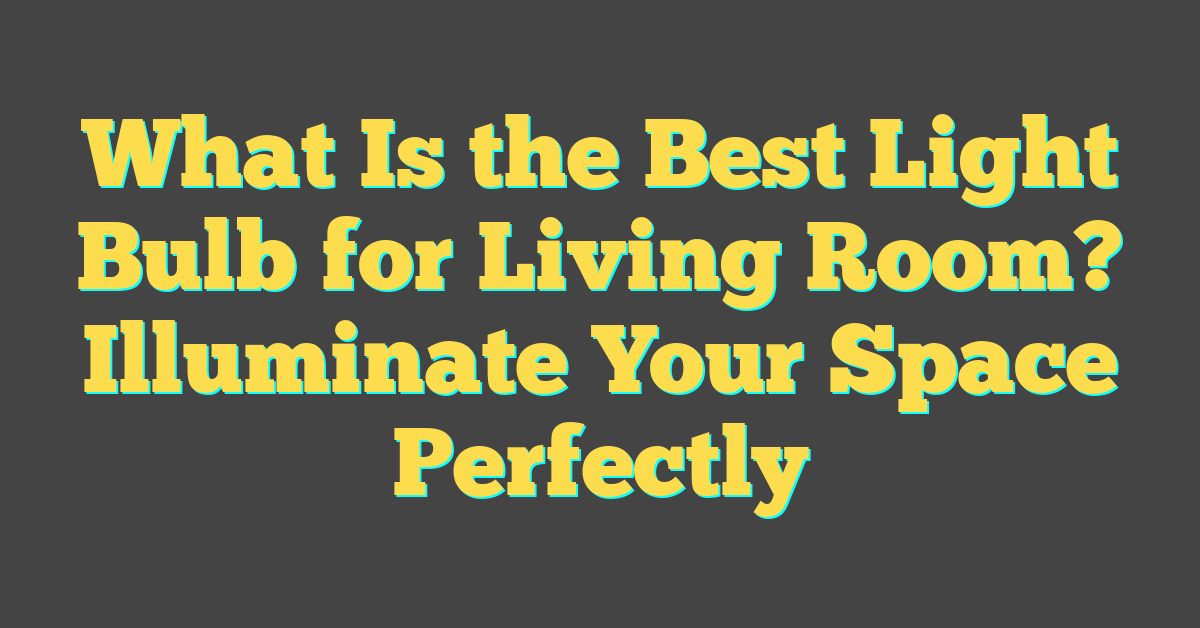Choosing the right light bulb for your living room isn’t just about brightness; it’s about setting the perfect ambiance for your home. You want a light that complements your decor, saves energy, and creates a cozy atmosphere where you can relax or entertain.

With so many options out there—LEDs, CFLs, halogens, and more—it’s easy to get lost. You’re looking for that sweet spot between efficiency and comfort, and we’re here to help you find it. Let’s dive into the world of lumens, color temperatures, and energy savings to discover the best light bulb for your living space.
Factors to Consider When Choosing a Light Bulb
When you’re picking the perfect light bulb for your living room, think about more than just flipping a switch. You’re setting the stage for every moment that’ll unfold in the space. It’s where you’ll curl up for movie nights, host vibrant gatherings, or unwind with a good book. That’s why the brightness, color, and efficiency of your light bulb matter so much.
Brightness is measured in lumens, not watts. Here’s a quick guide:
- Reading or task lighting: 1,000-1,600 lumens
- General ambient lighting: 1,600-2,200 lumens
Matching the right level of brightness to your living room’s needs can transform the area from a casual spot to a focused workspace with ease.
Next up, consider the Color Temperature. Measured in Kelvin, this isn’t about heat but the shade of light. A lower Kelvin number means a warmer, more amber glow, perfect for cozy evenings. A higher number yields a cooler, blue-toned light, great for concentration.
| Color Temperature | Lighting Quality |
|---|---|
| 2700K – 3000K | Warm, welcoming light |
| 3500K – 4100K | Neutral, crisp light |
| 5000K – 6500K | Daylight, energizing |
Remember that a living room is for living! So a bulb with a color temperature around 2700K to 3000K is usually a comfortable choice.
Don’t overlook the Energy Savings. LEDs can lead to significant reductions in energy bills and are far more eco-friendly than halogens or CFLs. Check the energy rating and calculate your potential savings before making a purchase. Over the lifespan of a bulb, the savings can be substantial.
Lastly, you’ll want to think about Dimmability and Smart Features. Having control over light levels can suit any mood or occasion, while smart bulbs with timers or that adjust to natural light levels ensure you’re getting light precisely when and how you need it.
Understanding Lumens and Color Temperatures

When you’re selecting the ideal light bulb for your living room, it’s crucial to know about lumens and color temperatures. Lumens measure the amount of light a bulb emits; it’s the brightness you feel the moment you flip the switch.
The traditional wattage ratings you grew up with actually tell you more about energy consumption rather than brightness. Contrary to what many think, a higher wattage doesn’t always mean brighter light, just more energy used. Here’s the gist: the higher the lumen value, the brighter your room will be.
It’s handy to know that most living spaces do well with bulbs that range from 1,500 to 3,000 lumens. The right level hinges on the size of your room and whether you’re after a soft glow or a bright ambiance to energize the space.
| Room Size | Suggested Lumens |
|---|---|
| Small (up to 10 sq. ft) | 1,500 – 2,000 |
| Medium (up to 20 sq. ft) | 2,000 – 2,500 |
| Large (up to 40 sq. ft & above) | 2,500 – 3,000 |
Beyond brightness, color temperature dramatically impacts the mood and functionality of your living room. Measured in Kelvin (K), color temperatures range from warm to cool, like the calm glow of sunrise to the noonday sun’s crisp light. Warm lights usually fall under 3000K and give off a cozy, inviting feeling, which is perfect for relaxing. On the other hand, cool lights above 5000K encourage concentration and alertness, making them less ideal for leisure-focused living rooms.
Remember, an average living room often benefits from a balanced 3000K to 3500K light bulb, striking a comfortable middle ground between warm and cool light.
- Tips for Picking Color Temperature:
- Warm White (2000K-3000K): Inviting & cozy, excellent for chill zones.
- Bright White (3100K-4500K): Crisp & vibrant, suitable for reading spots.
- Daylight (4600K-6500K): Exceptionally bright, better for task-oriented areas.
Different Types of Light Bulbs for Living Rooms
« Why Are Some Light Bulbs Yellow? Discover the Secret to Better Sleep
How Many Light Bulbs Are Sold Each Year? Unveiling the 10 Billion Bulb Boom »

When you’re on the hunt for the perfect light bulb for your living room, you’ll find there’s an array of options. Each comes with its own set of benefits tailored to your unique needs.
Let’s dive into the world of Incandescent Bulbs, the classic choice that’s been around for ages. They’re the masters of creating a warm, inviting glow, perfect for a cozy living room setting. But keep in mind, they’re not the top choice for energy efficiency.
Halogen Bulbs, incandescent’s close cousin, shine brighter and last longer while keeping that familiar warmth. They’re slightly better on the energy-saving front. However, they do run hotter than most, which is something to be mindful of.
Transitioning to the more energy-savvy, we encounter CFLs (Compact Fluorescent Lamps). They sip energy compared to incandescents and come in a variety of color temperatures. But they take a moment to warm up to their full brightness, which can be a tad inconvenient.
Then there’s the superstar of efficiency: LEDs (Light Emitting Diodes). Their lifespans are nothing short of impressive, and their energy consumption is minimal. They’ve come a long way in replicating the warm tones that were once unique to incandescents and offer a breadth of color temperatures and brightness levels.
Here’s a quick comparison to give you a clearer picture:
| Type | Lifespan (approx.) | Energy Efficiency | Color Temp. Range |
|---|---|---|---|
| Incandescent | 1,000 hours | Low | Warm |
| Halogen | 2,000 hours | Moderate | Warm to Neutral |
| CFL | 8,000 hours | High | Wide Range |
| LED | 25,000+ hours | Very High | Very Wide Range |
Remember, the best bulb for your living room also hinges on Dimmability and Smart Features. With progress in technology, LEDs especially have embraced these aspects, allowing for seamless integration with smart home systems for that perfect atmosphere you’re aiming for.
Pros and Cons of LED Light Bulbs

LED light bulbs have taken the lighting world by storm, and they’ve become a go-to option for many homeowners, especially when it comes to brightening up your living room. But even the most popular solutions have their advantages and drawbacks.
Longevity is one of the standout benefits of LED bulbs. They’re renowned for their long operational life, often outshining their counterparts by thousands of hours. It’s not unusual for an LED to last around 25,000 to 50,000 hours, reducing the hassle of frequent replacements. Plus, they are incredibly energy-efficient; LEDs use up to 75% less energy than traditional incandescent bulbs, leading to significant savings on your electricity bill.
Here’s a quick look at the lifespan and energy efficiency of LED light bulbs compared to other types:
| Type of Bulb | Lifespan (hours) | Energy Efficiency |
|---|---|---|
| LED | 25,000 – 50,000 | High |
| Incandescent | 750 – 2,000 | Low |
| Halogen | 2,000 – 4,000 | Moderate |
| CFL | 8,000 – 15,000 | Moderate to High |
LEDs also offer a wide color temperature range, which means you can tailor the ambiance of your living room from a warm, cozy glow to a bright, invigorating daylight feel. They’re often dimmable and come with various smart features that allow for customizable and remote lighting control.
Despite these glowing attributes, LEDs have their downsides. The initial cost can be a bit higher compared to other bulbs, which might be off-putting for some budget-conscious shoppers. While prices have decreased over time, the upfront investment is still something to consider.
Additionally, the quality of LED light can vary depending on the manufacturer. Lower-quality LEDs may flicker, change color over time, or even fail to provide the consistent light output they’re known for. It’s crucial to buy from reputable brands to avoid these issues.
When deciding on LEDs for your living room, weigh these pros and cons against your specific needs and usage patterns. Keep in mind that investing in quality LEDs not only enhances the comfort and aesthetic of your space but can also contribute to long-term savings and a reduced carbon footprint.
Tips for Creating the Perfect Lighting in Your Living Room

Your living room is a space of versatility, and the lighting should complement that. Striking the right balance is key to creating an inviting atmosphere. You’ll want to think about how each area of the space is used and plan your lighting accordingly.
Start by considering the layout of your living room. Where are the focal points? Perhaps you have a stunning fireplace or a cozy reading nook. Use accent lighting to highlight these features. Track lighting or wall-mounted fixtures can be ideal here. They allow you to direct light exactly where you want it, enhancing the room’s character and function.
Next, think about the mood you’d like to set. Soft, warm light creates a relaxed environment, perfect for unwinding at the end of the day. On the other hand, for tasks like reading or crafting, a brighter, whiter light is needed. Adjustable lamps with dimmable LED bulbs offer versatility and can cater to both these needs without much fuss.
Don’t forget about layering your lighting. This isn’t just a design trend; it’s a practical approach to lighting your space effectively. Combine ambient light from ceiling fixtures with task lighting and accent lighting. It ensures that every inch of your living room is well-lit, but also that it can be adjusted for any situation.
Let’s talk about control systems. Smart lighting systems have revolutionized how we interact with our home environments. With smart LEDs, you can adjust brightness, color temperature, and even set schedules right from your phone, creating the perfect lighting scenario for any time of day. It’s worth investing in this technology for both convenience and energy efficiency.
Remember, the best lighting plan is one that can adapt to your living room’s multifunctional nature. By considering these aspects and experimenting with different lighting combinations, you’ll create a space that’s just as dynamic as your lifestyle.
Conclusion
Choosing the right light bulb for your living room isn’t just about brightness; it’s about creating an ambiance that complements your space and lifestyle. Remember to weigh the pros and cons of each bulb type and consider how features like dimmability and smart controls can enhance your living experience. Don’t be afraid to mix and match lighting styles to highlight your room’s best features. After all, the perfect lighting setup can transform your living room into a cozy haven for relaxation or a vibrant area for entertaining. So go ahead, play with light, and watch your space come alive.
Frequently Asked Questions
What are the main types of light bulbs for living rooms?
Incandescent bulbs, halogen bulbs, Compact Fluorescent Lamps (CFLs), and Light Emitting Diodes (LEDs) are the main types of light bulbs suitable for living rooms, each with their specific benefits and drawbacks.
How do the lifespans of different light bulbs compare?
LEDs typically have the longest lifespan, followed by CFLs, halogens, and then incandescent bulbs, which have the shortest lifespan of the group.
Which light bulb type is the most energy-efficient?
LED bulbs are the most energy-efficient, consuming less power and lasting longer than incandescent, halogen, and CFL bulbs.
What is color temperature and how does it affect living room lighting?
Color temperature measures the color of light emitted by a bulb, ranging from warm (yellow/red tones) to cool (blue/white tones). It affects the atmosphere of the living room, with warmer temperatures creating a cozy feel and cooler temperatures being ideal for task lighting.
Should I choose dimmable bulbs for my living room?
Yes, choosing dimmable bulbs can provide greater control over lighting intensity, enabling you to create the right mood for different activities and times of the day.
Why should I consider smart lighting for my living room?
Smart lighting systems allow you to adjust brightness, color temperature, and schedules from your phone, making it easy to customize your living room lighting for different scenarios and preferences, and even save energy by automating your lighting needs.
What is accent lighting and why is it important in a living room?
Accent lighting is focused light that highlights specific features or areas of a room, such as artwork or architectural details. It adds depth and dimension to a living room, creating a more dynamic and visually interesting space.
How can I create the perfect lighting in my living room?
Consider the layout of the room, use accent lighting to highlight focal points, decide on the mood you want to achieve, and layer different types of lighting (ambient, task, and accent) to create a versatile and comfortable environment. Experiment with various combinations of light sources to find the best setup for your space.




